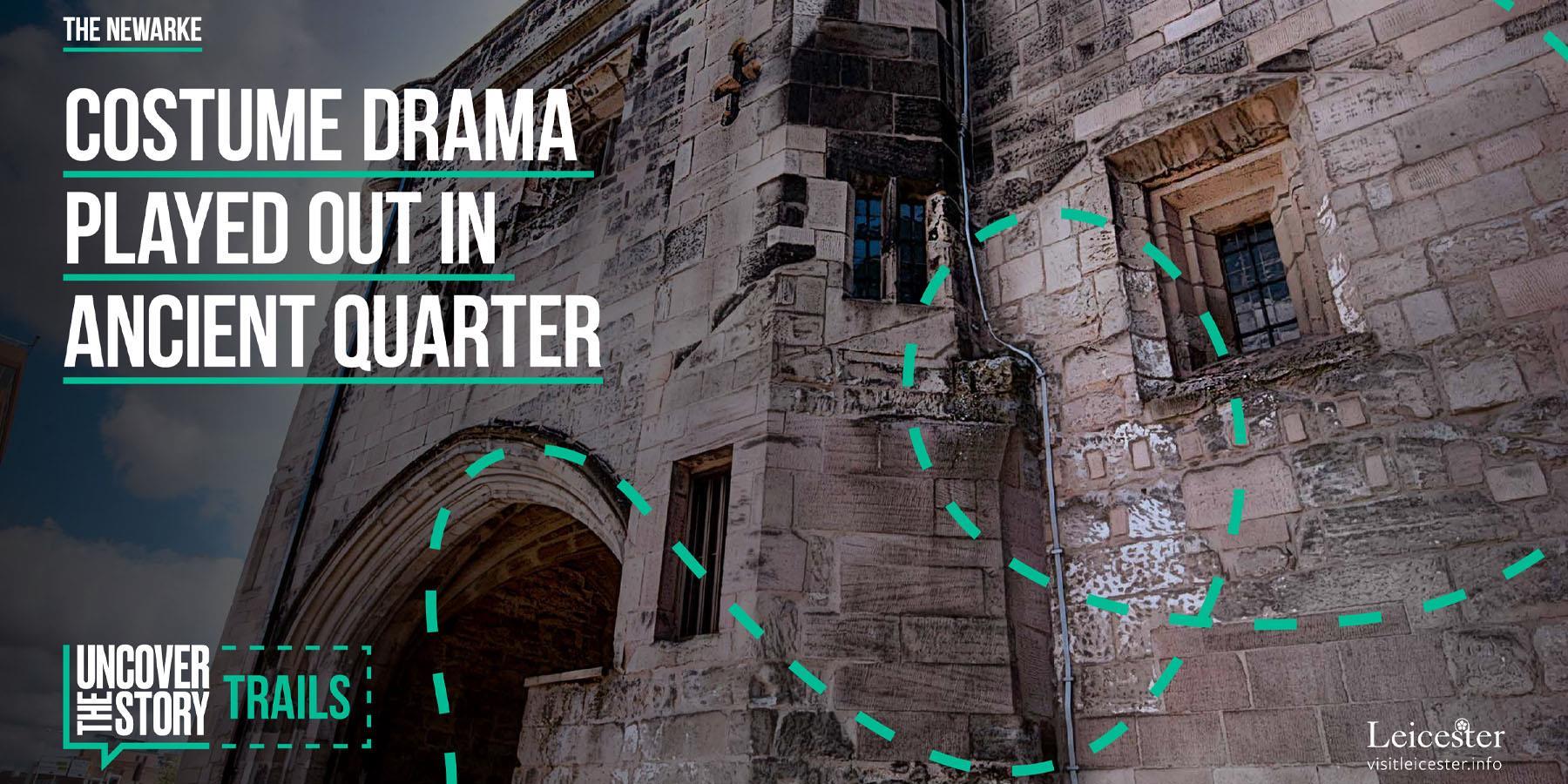The Newarke Gateway
/ The Magazine -
The Newarke Gateway was built around 1410 and is one of
Leicester’s finest medieval buildings. It was the entrance
from the southern part of the town into The Newarke
religious precinct. It is built of local sandstone with
separate arches for carriages and pedestrians.
In the late 1500s, the gateway was used to hold Catholics,
who were imprisoned for their religious beliefs. In the
1600s, during the English Civil War, it became a “magazine”
or store for gunpowder and weapons. In the 1800s it was
part of the military barracks and later used as a World
War I recruiting station.
The Newarke Houses Museum -
Created from two Tudor homes, Newarke Houses charts
the social history of Leicester, and includes clothing that
belonged to 53-stone Daniel Lambert, who put himself on
display to Georgian audiences as ‘the greatest curiosity in
the world’. Tales of the English Civil War take centre stage
outside in the museum gardens and within the Magazine
Gateway, a store for gunpowder and weapons. Discover
walls bearing scars of the muskets used by Roundheads,
battle-ready in their metal helmets and leather tunics,
to fend off Cavalier troops resplendent in their plumed
uniform headdresses.
Church of the Annunciation -
In the basement of De Montfort University’s (DMU)
Hawthorn Building, stand two arches which were once
part of a medieval church. Today these ruins form the
centrepiece for the university’s Heritage Centre.
The Church of the Annunciation of the Blessed Virgin Mary
was founded in 1353 by Henry the first Duke of Lancaster,
son of Henry who founded Trinity Hospital. The church is
nationally important as a site of Lancastrian burials as
well as the site of the public exhibition of the body of King
Richard II after his death at the battle of Bosworth in 1485.
The church was demolished in 1548 as part of
the Reformation.
Trinity Hospital and Chapel -
The Hospital of the Honour of God and the Glorious Virgin
and All Saints was founded in 1330 by Henry Plantagenet,
the 3rd Earl of Lancaster and Leicester, who was the
grandson of King Henry III. The hospital was built to care
for the poor and infirm.
Today the chapel is the oldest and least altered section
of the building. To the left of the altar is almost certainly
the tomb of Lady Mary Hervey, who was governess to the
children of Henry IV.
In the late 1700s, the crumbling medieval hospital was
rebuilt at the expense of King George III. In 1994 the
hospital and chapel buildings were purchased by De
Montfort University and form part of its campus.
Turret Gateway -
The Turret Gateway separated the Newarke religious
precinct from Leicester Castle. Probably built in 1423,
it was one of the two entrances to the enclosed Newarke
area. Within the enclosure would have been the Church
of the Annunciation, a hospital, a chantry house and
priests’ houses.
The Turret Gateway is also known as Rupert’s Gateway.
Prince Rupert and King Charles I commanded the royalist
army that captured Leicester Castle in 1645 during the
English Civil War. The gateway survived the English Civil
war only to be badly damaged in an election riot in 1832.
Castle Motte -
For a front-row view of what was once a Saxon town,
climb the Castle Motte, probably built in 1068 on the orders
of William the Conqueror. From this earth mound, look
down to St Mary de Castro, the church where a doubletclad Geoffrey Chaucer, author of The Canterbury Tales,
married, and where child king Henry VI was knighted
among much theatrical pomp and ceremony.
The Castle Motte is open to the public and can be
accessed through a path in Castle Gardens or from the
Castle Square.
Leicester Castle -
A motte-and-bailey castle was built in about 1068 and
became the centre of power for the first Norman overlord
of Leicester, Hugh de Grandmesnil. In 1107, Robert de
Beaumont, first Earl of Leicester is thought to have
replaced the timber defences with stone. Circa 1150, his son
Robert ‘le Bossu’ (the hunchback) built the Great Hall.
Leicester Castle’s Great Hall is the oldest surviving aisled
and bay divided timber hall in Britain. It still retains
some of its original 12th-century timber posts. Following
the restoration of The Great Hall, it is now home to the
Leicester Castle Business School — De Montfort University.
St Mary de Castro — Chaucer -
St Mary de Castro means St Mary of the Castle, reflecting
the church’s origins as a place of worship built within the
fortified enclosure, or bailey, of Leicester Castle. During the
Medieval times, St Mary de Castro would have had great
importance and much wealth. It is likely King Richard III
would have taken mass and worshipped here when visiting
Leicester Castle.
King Henry VI was knighted here when he was 4 years
old (at the same time as Richard Duke of York) and it is
thought that Geoffrey Chaucer, author of the “Canterbury
Tales” married his second wife her in the 1360s.
The church has been much altered but some early features
have survived including Norman doorways, 13th century
font and grotesque heads around the exterior.

